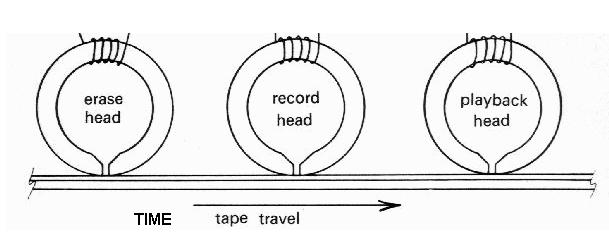ANALOG
RECORDING:
In analog recording, we set up an
analogy between parameters (variables) of the original sound, and
parameters of the recording medium. We vary some parameter of the medium
in correspondance to changes in the sound wave. The two sound parameters
we usually use are time and amplitude.
Vinyl Disk:
In phonograph
recording, changes in the amplitude of the original sound, cause changes in the
depth of the groove we cut into the surface of the disk. The louder the
instantaneous amplitude of the sound, the deeper we cut.
Time is represented
as distance along the spiral groove. As the stylus moves from the outside
edge toward the centre; the diameter decreases. Since the disk rotates a
constant speed -- 33- 1/3 rpm -- the linear speed decreases near the centre.
Scratches and dirt on the disk surface, disrupt
the amplitude analogy; causing noise (pops and crackle) in the playback.
Warping of the vinyl material disrupt the time analogy; causing changes in
pitch (warble or wow). Irregularities in the composition of the vinyl
disrupt the amplitude analogy randomly; causing surface noise.
|

|
Film Sound:
In photographic or
optical film sound tracks, changes in amplitude of the original sound
cause changes in the width of the clear area of the optical track. The
louder the instantaneous amplitude of the sound, the wider we make the sound
track.
Time is represented
as distance along the film. Film speed is constant -- 18 in./sec
for 35 mm. film. Scratches and dirt on the film
surface, disrupt the amplitude analogy; causing noise (pops and crackle) in the
playback. Shrinkage of the film with age disrupt the time analogy;
causing changes in pitch (warble). Inadequecies in the photo-chemical
process disrupt both amplitude and time analogies; causing distortion.
|

|
Magnetic Recording:
In magnetic
recording, changes in amplitude of the original sound cause changes in the
strength of the magnetic field stored on the recording tape. The louder
the instantaneous amplitude of the sound, the greater the magnetic
field.
Time is represented
as distance along the recording tape. Tape speed is constant -- 7.5 or 15
in./sec for reel to reel; 1- 7/8 in./sec for cassette.
|

|
On a professional reel to reel recorder, such
as the Revox PR99, the tape moves from the left supply reel, past the
tape guides and head block, between the capstan and pinch roller and onto the
right take up reel. In the recording mode, the
erase head erases the previously recorded signal. The record
head records a new signal on the tape; and finally, the playback
(replay) head plays the just recorded signal. The replay head serves
to provide confidence playback to ensure the quality of the recording. Because
of the spacing between the record and play heads, there is a noticeable delay
in the confidence playback; dependent on tape speed.
In the play mode, the erase and record heads are not
used.
|

|
The erase, record and playback heads are
electomagnets; coils of wire wrapped around pieces of iron (or other magnetic
material). A space in the magnetic material, called the gap;
concentrates the magnetic field. The erase head has a very wide gap to
provide the maximum erasure. The record and play heads have narrower gaps
to maximize reponse to high frequencies (short wavelengths).
|

|
Stray magnetic fields, from loudspeakers,
electric motors or computer monitors can demagnetise (erase) parts of the tape;
disrupting the amplitude analogy; causing drops in signal level.
Stretching or shrinking of the plastic tape disrupts the time analogy; causing
pitch changes (wow and flutter). Loss of the magnetic coating (oxide
shedding) dsirupts the amplitude analogy; causing drops in signal level
(dropouts). The random variation in magnetic particle size also disrupts
the amplitude analogy; cauing tape hiss. The tape
heads, guides, capstan and pinch roller must be cleaned regularly with alcohol
to remove glue from splicing tape, finger print oils and wax pencil
grease.
The moving magnetic
field of the tape can magnetise metal parts in the tape path and these must be
periodically de-magnetised; otherwise noise will be added to your tape during
each playback.
|
|

